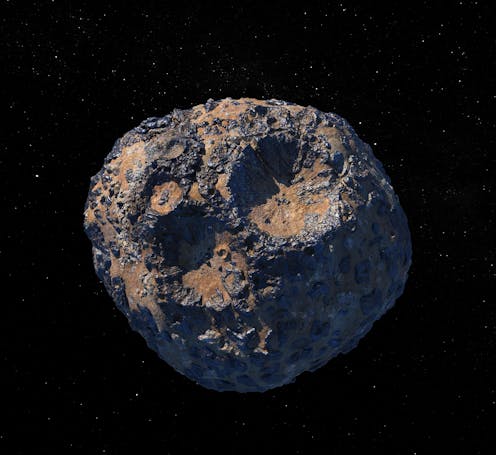A 3.6 billion kilometre 'journey to the centre of the Earth'
- Written by Hrvoje Tkalčić, Professor, Head of Geophysics, Director of Warramunga Array, Australian National University

Psyche was the Greek goddess of the soul, born a mere mortal and later married to Eros, the God of love. Who knows why the Italian astronomer Annibale de Gasparis gave her name to a celestial object he observed one night in 1852?
Psyche was only the 16th “asteroid” ever discovered: inhabitants of the Solar System that were neither the familiar planets nor the occasional visitors known as comets. Today we know the asteroid belt between the orbits of Mars and Jupiter contains millions of space rocks, ranging in size from the dwarf planet Ceres down to tiny pebbles and grains of dust.
Among all these, Psyche is still special. With an average diameter of around 226km, the potato-shaped planetoid is the largest “M-type” asteroid, made largely of iron and nickel, much like Earth’s core.
Last week NASA launched a spacecraft to rendezvous with Psyche[1]. The mission will take a six-year, 3.6 billion kilometre journey to gather clues that Earth scientists like me will interrogate for information about the inaccessible interior of our own world.
Natural laboratories
M-type asteroids like Psyche are thought to be the remnants of planets destroyed in the early years of the Solar System. In these asteroids, heavier elements (like metals) sank toward the centre and lighter elements floated up to the outer layers. Then, due to collisions with other objects, the outer layers were torn away and most of the material was ejected into space, leaving behind the metal-rich core.
These metallic worlds are perfect “natural laboratories” for studying planetary cores.
Read more: Nasa's Psyche mission is set for launch – here's how it could unveil the interior secrets of planets[2]
Our current methods for studying Earth’s core are quite indirect. We sometimes get tiny glimpses into the Solar System’s early history – and hence our planet’s own history – from metallic meteorites, parts of asteroids that fall to Earth. However, this view is very limited.
Another way to study the core is using seismology: studying how the vibrations caused by earthquakes travel through the planet’s interior, in much the same way doctors can use ultrasound to see the inside of our bodies.
However, on Earth we have fewer seismographs in the oceans and in the Southern Hemisphere, which restrict what we can see of the core.
What’s more, the core is buried beneath the planet’s outer layers, which obscure our view even further. It is like looking at a distant object through an imperfect lens.
As well as seismology, we learn about the core through lab experiments attempting to recreate the high pressures and temperatures of Earth’s interior.
We take the observations from seismology and lab experiments and try to explain them using computer simulations. In a recent paper in Nature Communications[3], we discussed the current challenges in studying Earth’s core – and the ways forward.
What the Psyche mission hopes to discover
We can think of NASA’s mission to Psyche as a journey to the centre of Earth without having to travel down through the planet’s rocky crust, the slowly moving mantle and the liquid core.
The mission aims to find out whether Psyche really is the core of a destroyed planet, that was initially hot and molten but slowly cooled and solidified like the core of our planet. On the other hand it’s possible Psyche is made of material that was never melted at all.
Read more: What are asteroids made of? A sample returned to Earth reveals the Solar System's building blocks[4]
NASA also wants to discover how old Psyche’s surface is, which would reveal how long ago it lost its outer layers. The mission will also investigate the asteroid’s chemical composition: whether it contains lighter elements alongside iron and nickel, such as oxygen, hydrogen, carbon, silicon and sulphur. The presence or absence of these could give us clues about our own planet’s evolution.
Information about Psyche’s shape, mass, and gravity distribution will also be gathered. Also, the potential for future mineral exploration should be studied.
All of this will be possible with the broad-spectrum cameras, spectrometers, magnetometers, gravimeters and other instruments the spacecraft carries. Scientists like me will follow with impatience the mission’s long journey through space.
References
- ^ launched a spacecraft to rendezvous with Psyche (www.jpl.nasa.gov)
- ^ Nasa's Psyche mission is set for launch – here's how it could unveil the interior secrets of planets (theconversation.com)
- ^ a recent paper in Nature Communications (www.nature.com)
- ^ What are asteroids made of? A sample returned to Earth reveals the Solar System's building blocks (theconversation.com)

















